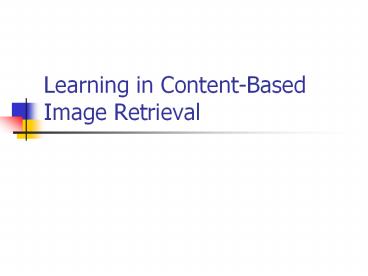Learning in ContentBased Image Retrieval - PowerPoint PPT Presentation
1 / 24
Title:
Learning in ContentBased Image Retrieval
Description:
Use Unlabeled Data. Conclusion. Introduction. In Content-based image retrieval (CBIR) ... use unlabeled data for enhancing classification accuracy, ... – PowerPoint PPT presentation
Number of Views:59
Avg rating:3.0/5.0
Title: Learning in ContentBased Image Retrieval
1
Learning in Content-Based Image Retrieval
2
Outline
- Introduction
- Small sample Learning Issue
- Word Association via Relevance Feedback
- ImageGrouper
- Use Unlabeled Data
- Conclusion
3
Introduction
- In Content-based image retrieval (CBIR)
- Small Sample learning issue
- There is a gap between high-level semantics in
human minds and low-level feature computable
by machines - A major difficulty for learning during relevance
feedback is relatively small number of
training samples available from users.
- Word Association
- Some of image databases have limited keyword or
key-pharse annotations. It is desirable to
seamlessly incorporate low-level features and
high level semantic keywords.
4
Introduction
- ImageGrouper
- An interface design for users that allow to
select and group examples from mutiple rounds
of interactions , and make overlapping
annotations to different groups of image
- Using Unlabeled Data
- use unlabeled data for enhancing classification
accuracy, learning process and improve
classification results.
5
Small sample Learning Issue
- Relevance feedback problem
- Positive Examples
- Negative Examples
- (they can belong to any class)
6
Small sample Learning Issue
Positive Examples
Negative Examples
Negative Examples
X
Negative Examples
Negative Examples
7
Biased Discriminant Analysis (BDA)
8
Nonlinear BDA using Kernel
9
Nonlinear BDA using Kernel
10
Result
Visual features color moments , wavelet
moments, water-filling structural features.
11
Word Association via Relevance Feedback (WARF)
- The performance of CBIR is inherently constrained
by use of the low level features. - Word Association Via relevance Feedback (WARF)
add the unification of keywords to improve the
retrieval performance.
12
WARF
CBIR
Low LevelFeatures
Improved Retrieval Result
Texture Annotations
(Keywords spotting from text such as HTML text on
webpages or manual annotations)
13
WARF
14
ImageGrouper
- The more query examples are available ,the better
result we can get - Refine the search adding example images.
- Additional examples may contain undesired
features and degenerate the retrieval performance
15
ImageGrouper
- Traditional interface does not allow the user to
put aside the query results for later uses. - Because of users of CBIR are not necessarily
looking for only one type of image. Interest may
change during retrieval
16
ImageGrouper
17
ImageGrouper
- Left Pane ResultViews the result of both
Content-based and Keyword-based search. - Right Pane GroupPaletteuser handles image
groups and specifty it as relevant, irrelevant or
neutral.( Neutral do not contribute to the
search at the moment )
18
ImageGrouper
- Compare with the traditional GUI for CBIR.
ImageGrouper is much easier to try different
combinateion of query examples. - It provides storage area for images that are not
used for query at the moment.
19
ImageGrouper
Example
- Assume the user is looking for red car
- She can initially collect car with any color.
- Once she found enough number, she can divide them
into 2 groupsred cars ( set as relevant )other
cars ( irrelevant ) - Furthermore, the user can annotate text
information to each group , this text can be used
for keyword-based search
20
Using Unlabeled Data
- Expectation-Maximization (EM)
- E-step
- M-step
- Loop
21
Using Unlabeled Data
- Discriminant Expectation-Maximization (D-EM)
- E-step
- D-step
- M-step
- Loop
22
Using Unlabeled Data
23
Using Unlabeled Data
24
Using Unlabeled Data































